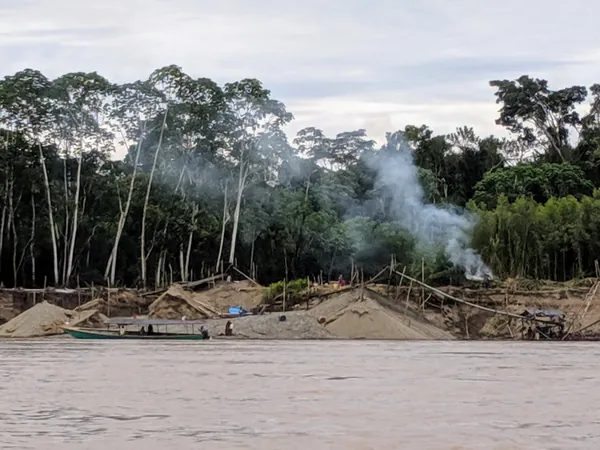
Trees as Silent Witnesses: Revealing Illegal Gold Mining's Mercury Footprint in the Amazon
2025-04-08
Author: Noah
Introduction
The Amazon rainforest, a majestic ecosystem and one of our planet's crucial lungs, has been under siege for centuries due to the relentless pursuit of gold. Today, as demand for this precious metal continues to rise, the hunt for gold has intensified, pushing artisanal and small-scale miners deep into the forest. This mining not only wreaks havoc on the environment but also poses dire risks to human health due to the rampant release of mercury (Hg) – a toxic element that significantly contaminates the air and waterways.
Groundbreaking Study
A groundbreaking study by an international team of researchers has revealed that tree rings in the Amazon can serve as a powerful tool for monitoring this toxic mercury. By examining species such as Ficus insipida, native to the Peruvian Amazon, scientists have established that these trees could essentially act as living archives, documenting the historical release of atmospheric mercury linked to illegal gold mining activities.
Significance of the Findings
Dr. Jacqueline Gerson, an assistant professor at Cornell University and the study’s lead author, stated, "We show that Ficus insipida tree cores can be used as a biomonitor for characterizing the spatial and potentially the temporal footprint of mercury emissions from artisanal gold mining in the neotropics." The implications are staggering: through the analysis of tree ring samples, researchers can pinpoint not only the presence of mercury but also infer when and where these emissions occurred, thus shining a light on the dark underbelly of illegal mining.
The Mining Process and its Consequences
Mining for gold typically involves miners adding mercury to soil containing minuscule gold particles. The mercury amalgamates with the gold, creating a compound easy to extract through burning, which, unfortunately, releases mercury vapor into the air. This process poses severe health risks for local populations and impacts wildlife.
Research Findings
The team focused on three different neotropical tree species, primarily examining Ficus insipida, which not only shows annual growth rings but also exhibits varying mercury concentrations based on location. Tree core samples were taken from sites both near and far from mining activities, providing a comparative insight into mercury levels. The findings were stark: tree samples closer to mining sites demonstrated significantly higher levels of mercury compared to those taken from protected areas or distant from mining operations.
Mercury Levels and Mining Activity
After the year 2000, mercury levels began to spike near towns where amalgams were being processed, indicating a troubling rise in mining activity during this period. "In the Peruvian Amazon, where mining is the primary source of mercury pollution, it is clear that higher mercury concentrations are closely tied to the proximity of mining activities," Gerson noted.
Challenges in Monitoring
While this innovative approach to biomonitoring reveals crucial information about mercury emissions, researchers acknowledge the challenges in their findings. The clandestine nature of illegal mining operations complicates the ability to accurately gauge the distances from these sites, which could further affect the mercury concentrations found in tree rings.
Conclusion and Implications
The study concludes that Ficus insipida offers a promising, cost-effective method to examine large-scale trends in mercury emissions, potentially enabling environmental agencies and activists to better combat illegal mining practices. In the fight for the Amazon's survival, these trees could indeed be unsung heroes, uncovering a hidden narrative of environmental damage and prompting calls for greater protections against illicit activities that threaten this vital ecosystem.
As global attention increases on the need for sustainable practices and environmental restoration, the implications of this study underscore the importance of using every tool at our disposal, including nature itself, to safeguard our planet's future.









 Brasil (PT)
Brasil (PT)
 Canada (EN)
Canada (EN)
 Chile (ES)
Chile (ES)
 Česko (CS)
Česko (CS)
 대한민국 (KO)
대한민국 (KO)
 España (ES)
España (ES)
 France (FR)
France (FR)
 Hong Kong (EN)
Hong Kong (EN)
 Italia (IT)
Italia (IT)
 日本 (JA)
日本 (JA)
 Magyarország (HU)
Magyarország (HU)
 Norge (NO)
Norge (NO)
 Polska (PL)
Polska (PL)
 Schweiz (DE)
Schweiz (DE)
 Singapore (EN)
Singapore (EN)
 Sverige (SV)
Sverige (SV)
 Suomi (FI)
Suomi (FI)
 Türkiye (TR)
Türkiye (TR)
 الإمارات العربية المتحدة (AR)
الإمارات العربية المتحدة (AR)